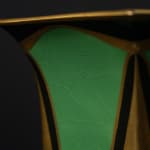Ernst Wahliss Austrian, 1837-1900
c. 1910
4.5h x 6w inches
Further images
Secessionist Porcelain Vase by ERNST WAHLISS (1837-1900) for SERAPIS WAHLISS, Vienna, c. 1900. The Serapis Wahliss rectangular mark printed in green verso, the style number 9815 F impressed, F. 9815/.II.9916 painted in brown verso, and 23 painted in black; measuring: 4.5 x 6 inches. See photo. The esteemed Viennese retailer and manufacturer of porcelain and ceramic ware, Ernst Wahliss Kunst, Porzellan und Faience Fabrik rolled out its Serapis Wahliss line in 1911. The firm had acquired 600 original models of table china from the moulds once belonging to the K.K. Austro-Hungarian factory that had closed in 1864. With new designers, like Karl Klaus, who were part of the Jugendstil movement now on board, their “luxury porcelain” designs reflected decidedly modern trends. The influence of Josef Hoffmann, Klaus’ instructor in Vienna at the Kunstgewerbeschule from 1907-1911, is apparent in the geometric patterning and reliance on a simple, but bold, palette. Klaus’ alliance to Hoffmann and his vision for elevating the applied arts to the same status as the Fine Arts continued on a professional level. The Wiener Werkstatte employed Klaus in 1911, which would remain under the directorship of Hoffmann until its demise in 1932. The scrollwork Klaus incorporated into his design on the domed lid for Serapis Wahliss demonstrates this tie to the Werkstatte and in particular a stylistic affinity to another one of its leading designers, Carl Otto Czeschka.









